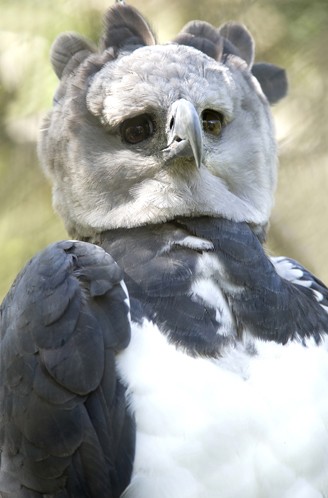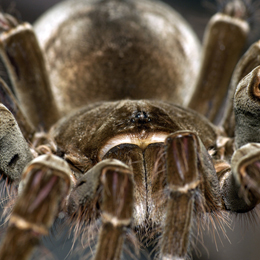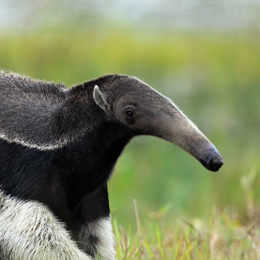Description
The Harpy eagle, scientifically named as Harpia harpyja, is the only species in its Genus. The name “Harpy” may have a Greek origin. In Ancient Greek Mythology, harpies were female wind spirits or beasts, having an eagle’s body and a humans' head. It is possible that the crested head and the massive size of female harpy eagles could’ve been one of the reasons why the name “Harpy” was attached to it. The species Harpia harpyja is also occasionally referred to as the American harpy eagle in order to distinguish it from the closely related New Guinea harpy eagle (Harpyopsis novaeguineae).
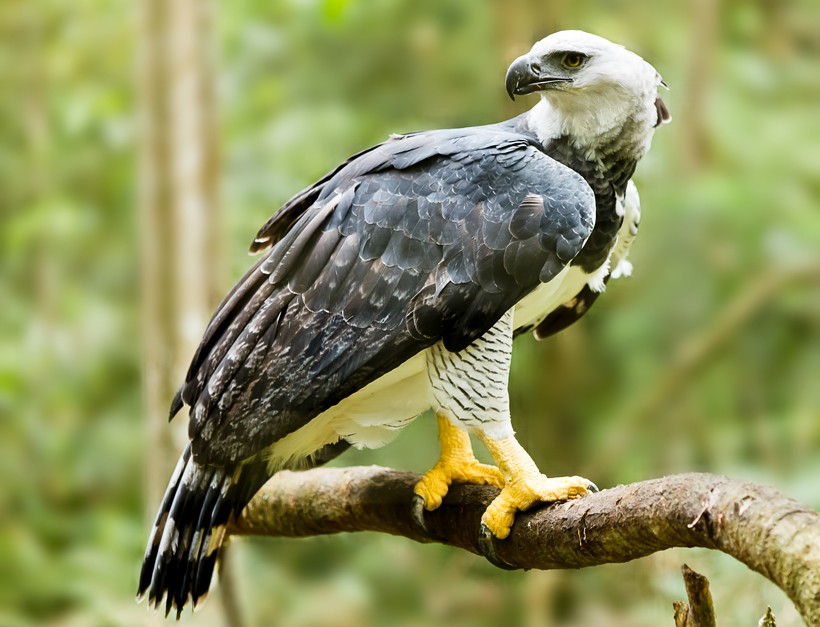
The Harpy Eagle uses its large strong claws to crush the skull of its prey, delivering an instant death to its victim
?
Image credits: MarcusVDT/Shutterstock
Males and females of Harpia harpyja possess an identical plumage. They have gray or slate-black feathers on their back while the abdomen is white in color. The head is pale gray and a black band on its chest separates it from the white abdomen. Both males and females have a double crest on the back of their head. The females of this species can be easily distinguished as they grow twice as large as the males.
The harpy eagle is one of the heaviest of all eagle species. The Steller’s sea eagle is the only species that grows heavier than harpy eagles. A captive harpy eagle female named “Jezebel” weighed as much as 12 kg. In the wild, adult female harpy eagles can weigh up to a whopping 8 to 10 Kg, whereas the weight of males ranges between 4 to 5 Kg on average. A harpy eagle can live as long as 25 to 35 years in the wild. Beside the single heaviest, the eagle is also one of the largest eagles on earth, growing up to 85 to 105 cm in length with a wingspan of up to 2 meters; making harpy eagles second to only Philippine eagles, in terms of length.
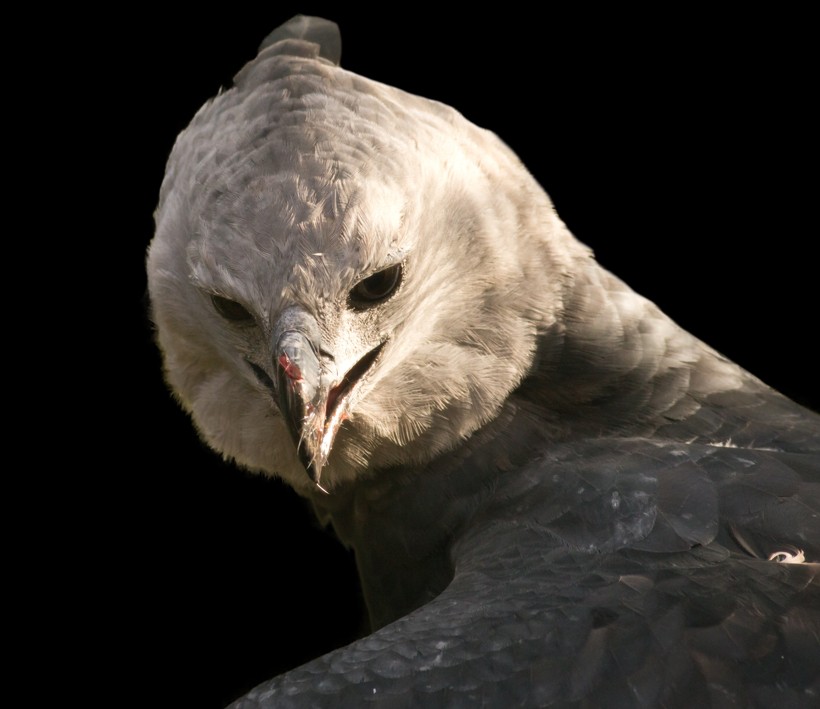
The bird Fawkes, the intelligent Phoenix of Albus Dumbledore in the Harry Potter film series was inspired by the Harpy Eagle.
?
Image credits: Lukas Gojda/Shutterstock
Like most eagles, the harpy eagle has an exceptional sense of vision. The eyes consist of several tiny sensory cells that allow this predator to spot a prey from great distances. Harpy eagles are also equipped with an acute sense of hearing. The hearing is further enhanced by the facial feathers, which form a disc shape around its ears. This feature is quite common among owls; the disc shape projects the sound waves directly to the ears of the bird, allowing the bird to hear the smallest movements around it.
However, for the harpy eagle, these super senses came at a good price. Harpy eagles have little to no sense of smell as they depend mostly on their vision and hearing. But their highly sensitive eyes don’t work that well during the night. It is believed by researchers that even humans have a better night vision when compared to that of eagles.
Reproduction and Life Cycle
Sexually mature harpy eagles start looking for a partner at the age of 4 to 5 years. Males and females of this species spend their lifetime with the same mate. At a lifespan of up to 25 to 35 years, a successful pair has spent up to 20 to 25 years together. Once they find a mate, a harpy eagle starts looking for suitable nesting sites.
The nest is usually built at a height of over 40 meters. Nest building is handled jointly by both sexes. Harpy eagles grab branches in their strong claws and flaps with their wings, causing the branch to break. Such branches are then brought back to the nesting site and aligned together to build a huge nest. Such nest has enough space for these large birds; on average, a harpy eagle’s nest is up to 150 to 200 cm in diameter and up to 1 meter in depth. Some harpy eagle pairs can make several nests in their lifetime while some prefer to repair and reuse the same nest again and again.
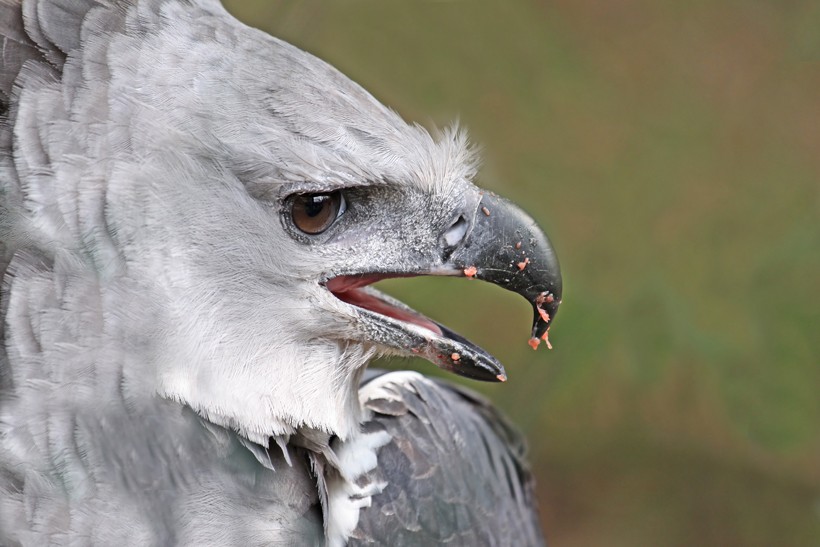
Male Harpy Eagle, Panama
?
Image credits: Claudia Otte/Shutterstock
Once their nest is prepared, copulation takes place and a few days later, the female lays 2 large pale white colored eggs. Incubation is done mostly by the female since the male is relatively quite small. During this period, males handle most of the hunting job and they only incubate the eggs for small time periods when the female takes a break for feeding. The incubation period for harpy eagle eggs is up to 55 days. Raising baby harpy eagles is a hectic job; that is why pairs raise only one hatchling at a time. Once one of the two eggs hatches, the pair ignores the second egg and indulges completely in parenting activities for the newborn.
The hatchling measures only a few inches in length at the beginning of its lifecycle. For the first few months after hatch, the female spends most of the time at the nest, while the male continues to do most of the hunting. The hatchling eats a lot as it grows very fast. The chick grows from a few inches at birth to the size of an adult in just 5 to 6 months. The chick fledges at the age of 6 months and it can fly like an adult in a few days after the first attempt. However, hunting requires a higher level of skills, which the juvenile perfects it in the first couple of years of its lifecycle. During that period, the chick is attempting small hunts, but it depends mostly on the parents for food. The adults feed the juvenile for a year or two and once the chick shows good hunting skills, it leaves its parents and starts an independent life in the wild.
The young harpy eagle spends a solitary life for the first few years. At the age of 5 to 6 years, it looks for a mate and the pair raises one chick every 2 to 3 years for the remaining 20 to 25 years of their lifespan.
Habitat & Behavior
Very little is known about harpy eagle’s behavior in the wild. Like most eagles, they are diurnal raptors as their sight is not very good at night. Adults are solitary hunters and begin living in pairs at the age of 5 to 6 years. Pairs have very large territories and they are hard to find in the dense tropical rainforests. However, nests are spotted very close to each other on locations that sustain higher numbers of harpy eagles. Unlike other raptors, harpy eagles don’t fly long distances. They prefer flying from tree to tree, taking small halts between flights while they search for prey in the dense vegetation of the harpy eagle habitat.
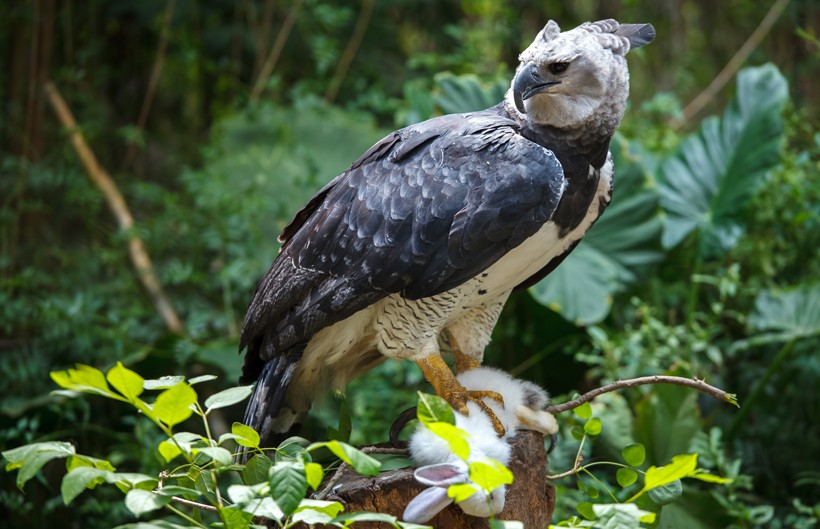
Harpy Eagle eating a bunny
?
Image credits: Chepe Nicoli/Shutterstock
Unlike other raptors of its size, harpy eagles have smaller wings and a longer tail. This is an adaptation, which allows the large harpy eagle to maneuver its flight path through the dense vegetation in the tropical rainforest. Harpy eagles prefer tropical rainforests and primarily prey on monkeys and sloths as their numbers are large in tropical regions. However, according to various researchers, the harpy eagle is a highly intelligent and opportunistic predator. Based on the remains of prey animals in its nest, it is concluded that harpy eagles may hunt any animal that ranges between 7 to 8 kg in weight. Residues of arboreal mammals, land mammals, large tropical birds and rarely also livestock are found in their nests, along with the residues of monkeys and sloths.
The harpy eagle talons are the strongest amongst all birds of prey. Once the prey is spotted the harpy eagle flies towards it at high speed. It pounces upon the prey and grabs its skull at a speed of over 80 km/hr. It then uses its large strong claws to crush the skull of its prey, delivering an instant death to its victim. As they hunt for large sized prey animals, harpy eagles don’t have to hunt every day. The eagle usually flies back to its nest with the prey and feeds on it for the next few days in the nest. Under harsh conditions, the harpy eagle can survive without food for up to a week.
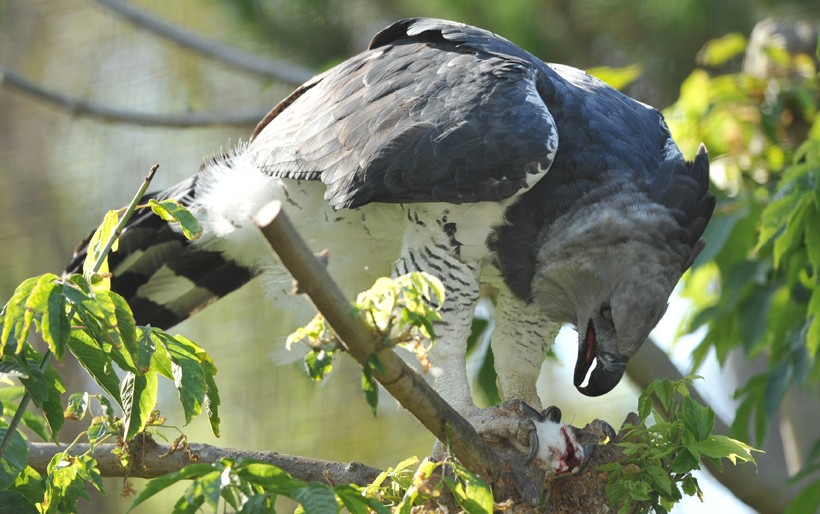
Harpy eagle feeding on a mouse
?
Image credits: worldswildlifewonders/Shutterstock
The Harpy eagle communicates with its mate using vocal calls. A sharp “wheeeee-wheeeee” call can be heard often when the birds are close to their nest. The males and females use these calls frequently to maintain contact while they are busy in parenting activities. The chick starts using similar calls at an age of 38 to 40 days.
These apex predators are fearless as they have no natural predators in the wild. Newly hatched chicks can be quite vulnerable due to their small size, but under the guard of its large mother, the chick has the best chance to survive.
Population and Conservation
Harpy eagles are distributed over a vast range in Central and Southern America. Though they have no natural predators in the wild, their numbers are declining throughout its range. In Central America, their range starts from Southern parts of Mexico and extends to the south of Panama. The species is considered almost extinct in most parts of Central America due to excessive logging and deforestation. However, Panama sustains a good number harpy eagles compared to the rest of Central America. This raptor is considered nation’s pride in Panama and was declared the national bird of Panama on 10th of April 2002. This declaration and the conservation efforts that followed are the primary factors working behind the existence of harpy eagle population in Central America.
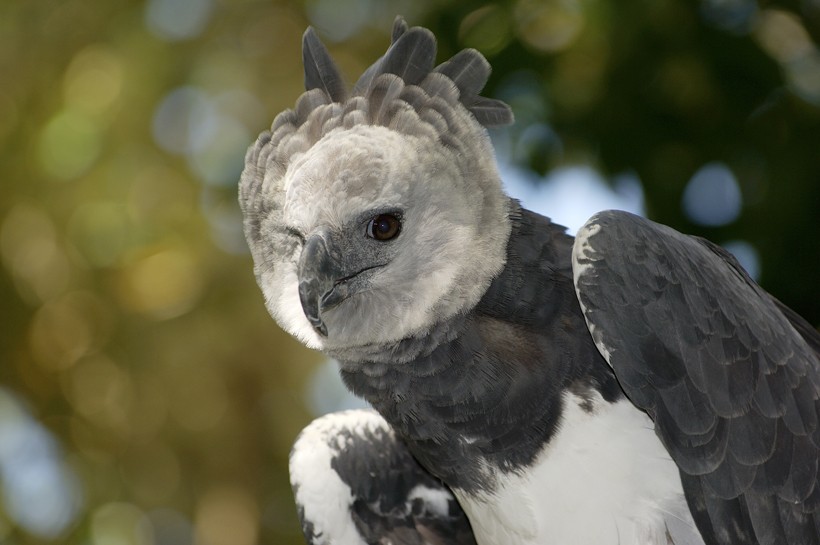
The harpy eagle is considered as a near threatened species
?
Image credits: Alfredo Maiquez/Shutterstock
In South America, the harpy eagle range lies between Venezuela in the North and extends up to Northern Argentina in the south of the continent. Harpy eagles are most commonly found in Brazil, which is home to a major part of the entire harpy eagle population.
However, sightings of wild harpy eagles are getting rarer as their natural habitat is being adversely affected due to human activity. Deforestation is considered to be one of the major causes for the decline in harpy eagle population. Throughout its range, logging is carried out on an industrial scale, resulting in loss of nesting sites and food sources. Though it is rarely seen hunting livestock, the species is seen as a threat to livestock due to its sheer size. Due to the myths and rumors about harpy eagles, locals see this magnificent creature with hatred and often hunt them down out of fear.
Several conservation campaigns have been conducted throughout its habitat range in order to protect this species from extinction. Several eagles have been raised and released in protected areas so that the raptor can survive in a safe environment. The 15th eagle released in Belize was nicknamed “Hope”.
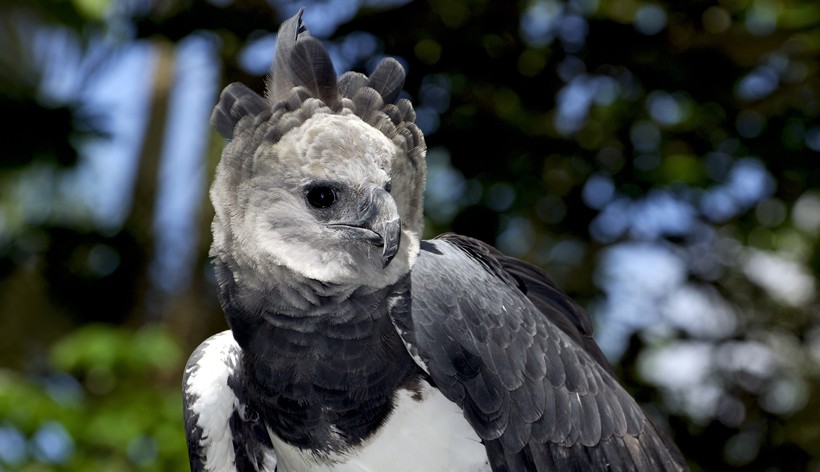
The Harpy Eagle is native to the south and central Americas
?
Image credits: Alfredo Maiquez/Shutterstock
Despite all efforts, the population decline continues. General awareness about the importance of this species is being spread amongst people, but unless the rapid rate of deforestation is halted, the magnificent creature may vanish from the wild in near future. There is no information about the exact population size of harpy eagles. Based on a survey conducted in 2008, it is estimated that less than 50,000 individuals remain in the wild. IUCN assessments conclude that the species has lost up to 45.5% of its suitable habitat over a time span of just 56 years. The species Harpia harpyja is thus marked as “Near Threatened” in the IUCN RED LIST assessment of 2012.
Harpy Eagles are apex predators and are very important for the tropical rainforest ecosystem. Saving the population can help in conservation of numerous tropical species that share its habitat. These raptors keep a check on the numbers of arboreal and land mammals of rainforests, eventually allowing the vegetation to flourish. Extinction of such an important creature may adversely affect the entire tropical rainforest ecosystem of Central and South America.
Evolution
Birds are often termed as living dinosaurs, as they have an ancestral history that dates back to the time of Dinosaurs. All modern birds evolved from prehistoric reptiles. Archaeopteryx, a reptile that lived on earth approximately 150 million years ago, is one of the most important links that reveal how birds evolved. Early bird-like reptiles had teeth and claws, along with feathery scales on their limbs and tail. Eventually, these reptiles evolved into birds. Modern raptors belonging to the family Accipitridae evolved in the early Eocene period. The first raptors were a group of scavenging and fishing birds, called kites. Over the course of time, these kites migrated to various habitats and developed adaptations, which allowed them to survive and flourish. Approximately 50 to 60 million years ago ancestors of harpy eagles reached the continent of America.
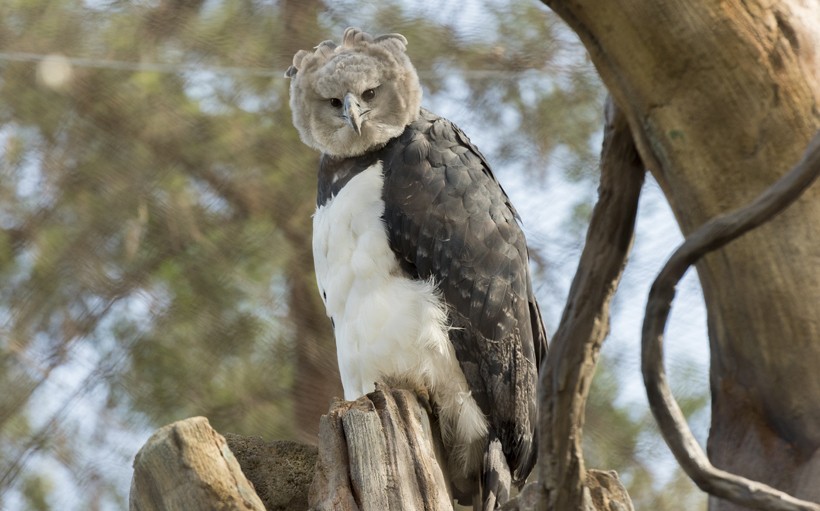
Harpy eagles prefer flying from tree to tree while they search for prey in the dense vegetation of the rainforest
?
Image credits: Jeannette Katzir Photog/Shutterstock
The Eagle gained size due to lack of predator competition and large availability of food sources. Before human interference, the harpy eagle was a highly successful creature, capable of taking down large prey animals. The evolution of strong claws and shorter wingspans, allowed this creature to hunt efficiently in the dense tropical rainforests.
Funfacts
- Harpy eagles are one of the largest and strongest of all eagles. The Steller’s sea eagle and Philippines eagle are the only two species that have a larger size and weight.
- Harpy Eagle talons are capable of shattering the bones of its prey.
- They are capable of catching prey animals that are over 7 kg in weight.
- Harpy eagles mate for life and the pair raises only one chick every 2-3 years.
- A harpy eagle can live for up to 25 to 35 years.
- Harpy eagles have lost half of their habitat during the last 50 years.
- It is the national bird of Panama.
- The bird Fawkes, the intelligent Phoenix of Albus Dumbledore in the Harry Potter film series was inspired by the Harpy Eagle.
